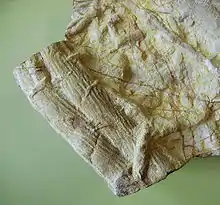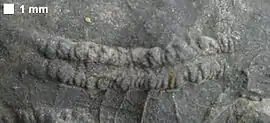Cruziana
Cruziana is a trace fossil consisting of elongate, bilobed, approximately bilaterally symmetrical burrows, usually preserved along bedding planes, with a sculpture of repeated striations that are mostly oblique to the long dimension. It is found in marine and freshwater sediments.[1] It first appears in upper Fortunian rocks of northern Iran and northern Norway.[2] Cruziana has been extensively studied because it has uses in biostratigraphy (specific scratch patterns are unique to specific time intervals),[3] and because the traces can reveal many aspects of their makers' behavior.
| Cruziana | |
|---|---|
 | |
| Cruziana, fossil trackways of trilobites. | |
| Trace fossil classification | |
| Kingdom: | Animalia |
| Phylum: | Arthropoda |
| Class: | †Trilobita |
| Ichnogenus: | †Cruziana d'Orbigny, 1842 |

Cruziana is typically associated with trilobites but can also made by other arthropods.[1] Cruziana appears in non-marine formations such as the Beacon Supergroup that would have been unsuitable environments for trilobites,[1] and in Triassic sediments that were deposited after trilobites became extinct at the end of the Permian Period.[4]
Cruziana traces can reach 15 mm across and 15 cm in length, with one end usually deeper and wider than the other.[1] The burrow may begin or end with a resting trace[5] called Rusophycus, the outline of which corresponds roughly to the outline of the tracemaker, and with sculpture that may reveal the approximate number of legs, although striations (scratchmarks) from a single leg may overlap or be repeated. Cruziana tenella, and conceivably other ichnospecies, appears to have been formed by the concatenation of a series of Rusophycus traces, suggesting that Cruziana is a feeding trace, rather than a locomotory trace formed by burrowing within a layer of mud as historically believed.[6]
The ichnogenus Diplichnites may be produced where the trackmaker sped up. Several specimens of Cruziana are commonly found associated together at one sedimentary horizon, suggesting that the traces were made by populations of arthropods.[1]
References
- Woolfe, K.J. (1990). "Trace fossils as paleoenvironmental indicators in the Taylor Group (Devonian) of Antarctica". Palaeogeography, Palaeoclimatology, Palaeoecology. 80 (3–4): 301–310. Bibcode:1990PPP....80..301W. doi:10.1016/0031-0182(90)90139-X.
- Daley, Allison C.; Antcliffe, Jonathan B.; Drage, Harriet B.; Pates, Stephen (22 May 2018). "Early fossil record of Euarthropoda and the Cambrian Explosion". Proceedings of the National Academy of Sciences of the United States of America. 115 (21): 5323–5331. Bibcode:2018PNAS..115.5323D. doi:10.1073/pnas.1719962115. PMC 6003487. PMID 29784780.
- Seilacher, A. (1994). "How valid is Cruziana stratigraphy?". Geologische Rundschau. 83 (4): 752–758. Bibcode:1994GeoRu..83..752S. doi:10.1007/BF00251073.
- Donovan, S. K. (2010). "Cruziana and Rusophycus: trace fossils produced by trilobites … in some cases?". Lethaia. 43 (2): 283–284. doi:10.1111/j.1502-3931.2009.00208.x.
- Garlock, T. L.; Isaacson, P. E. (1977). "An occurrence of a Cruziana population in the Moyer Ridge Member of the Bloomsberg Formation (Late Silurian)-Snyder County, Pennsylvania". Palaeontology. 51 (2): 282–287. JSTOR 1303607.
- Kesidis, Giannis; Budd, Graham E.; Jensen, Sören (2018). "An intermittent mode of formation for the trace fossil Cruziana as a serial repetition of Rusophycus: The case of Cruziana tenella (Linnarsson)". Lethaia. 52: 133–148. doi:10.1111/let.12303.
Further reading
- Goldring, R. (1 May 2009). "The formation of the trace fossil". Geological Magazine. 122 (1): 65–72. doi:10.1017/S0016756800034099.
- Jensen, Soren (2006). Trace Fossils from the Lower Cambrian Mickwitzia Sandstone, South-Central Sweden. Wiley. ISBN 978-82-00-37665-1.
- Vinn, O (2014). "Cruziana traces from the Late Silurian (Pridoli) carbonate shelf of Saaremaa, Estonia". Estonian Journal of Earth Sciences. 63 (2): 71–75. doi:10.3176/earth.2014.06.
External links
- Trackways and associated burrow; Photo--(Close-up); Graphic--(trilobite and burrow, etc)
- Argentine article on Cruziana "Remarkable Cruziana beds in the Lower Ordovician of the Cordillera Oriental, NW Argentina".
| Wikimedia Commons has media related to Cruziana. |
